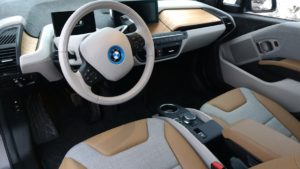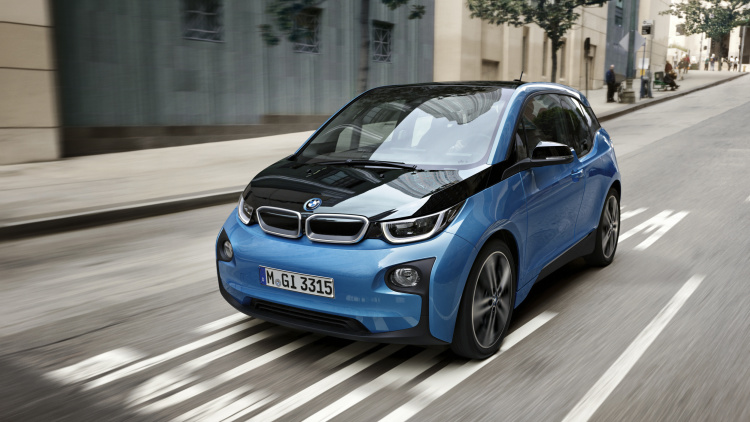By Shari Prymak
2017 BMW i3 REx - With its unique design, electric drivetrain, and exotic carbon fibre structure, the i3 is a bit like a car from the future. It represents a long-term thinking approach from BMW. This thinking is based on assumption that our current methods of transportation will soon become unsustainable due to urban congestion, pollution, and the dwindling supply of fossil fuel. BMW believes that the i3 can help solve many of these issues.
There’s no doubt that the i3 makes use of technology that is rarely, if not ever, seen on the mainstream side of the automotive market. The chassis is made from carbon fibre and the body panels are composite. This makes it very light compared to other electric vehicles, which helps with both efficiency and performance. It also means that rust is now a non-issue. A major bonus for those who have to deal with salt-covered winter roads.
The standard i3 has an all-electric range between 150-200 kilometres. That gives it an active radius of about 80 kilometres if you have to get back to your start point to charge and can’t plug in at your destination. Even though that’s significantly less than what you get from a Chevy Bolt or Tesla Model 3, it should be adequate for many urban drivers. It is also just enough to question the need for the optional range extender, which is a 2-cylinder gasoline generator that adds 100 kilometres of easy to replenish, available range. Passing on the range extender means full dependence on a plug, but it also lowers the maintenance and running costs. As an all-electric vehicle, the i3 will never require oil changes, spark plugs, or any other maintenance items unique to gasoline vehicles.
The i3 should be relatively hassle-free from a servicing perspective, but that doesn’t mean it’s not without its quirks. The unique 155/70-19 section tire size, for example, do pose certain challenges. At the time of writing, there are only two types of tires available for the i3, one all-season and one winter tire, both made by Bridgestone. Don’t expect your local garage or dealer to have these tires readily available. A unique, specific to one model, type of tire will be a special order deal, which means the i3 could be in the shop for a while waiting for replacements. There is a no spare tire either, which means that a flat tire could turn into a rather aggravating situation.

Like all electric cars, the driving experience of the i3 is largely dominated by quietness, smoothness, and an overall high level of refinement. I quickly adapted to the largely silent ride. The aggressive regenerative braking, however, does take a while to get used to. It takes effect the moment the accelerator pedal is lifted, and decelerates the i3 quick enough to make one pedal driving the norm under most situations.
In terms of handling, the i3 doesn’t have much of the Ultimate Driving Machine DNA for which BMW became famous. The skateboard-like placement of the batteries and motor do give the i3 a very low centre of gravity, however, the high riding position and skinny, low-grip, eco tires make any kind of high-speed spirited driving rather challenging. I have no complaints though when it comes to the acceleration. The i3 is brisk enough off the line to take on a few proper sports cars.
In any case, the urban dwellers that the i3 is targeted at will likely care more about the excellent outward visibility, incredibly tight turning circle, and airy cabin. Front seat occupants will find little to complain about. The flat floor means there’s plenty of leg room and space for a bag between the seats. The back seat, however, is rather tight, and the rear doors can’t be opened independently of the fronts due to the suicide-door design. With its IKEA-modern design theme and interesting use of eco-materials, the interior is just as unique as the exterior. It’s a nice place to just sit and stare.

Pricing for the i3 starts at $47,500 for the all-electric model and $52,000 when the gas range extender is added in. Options can quickly increase that total, but I’d avoid any extras since the standard equipment list is pretty generous. The i3 qualifies for a $13,000 electric vehicle incentive in Ontario, which brings the entry price down to $34,500. Not bad for a BMW made from exotic materials and fancy EV technology.
The i3 certainly has its appeal and should meet the criteria of many urban-based, electric vehicle shoppers. The limited interior space, polarizing design, and far from class-leading electric range mean that it will have a hard time being anything other than a niche player in the market. Still, it is a fine start, and proof that electricity does indeed offer a bright, clean future. At the current pace of development, I can’t wait to see what the future holds for this technology.

